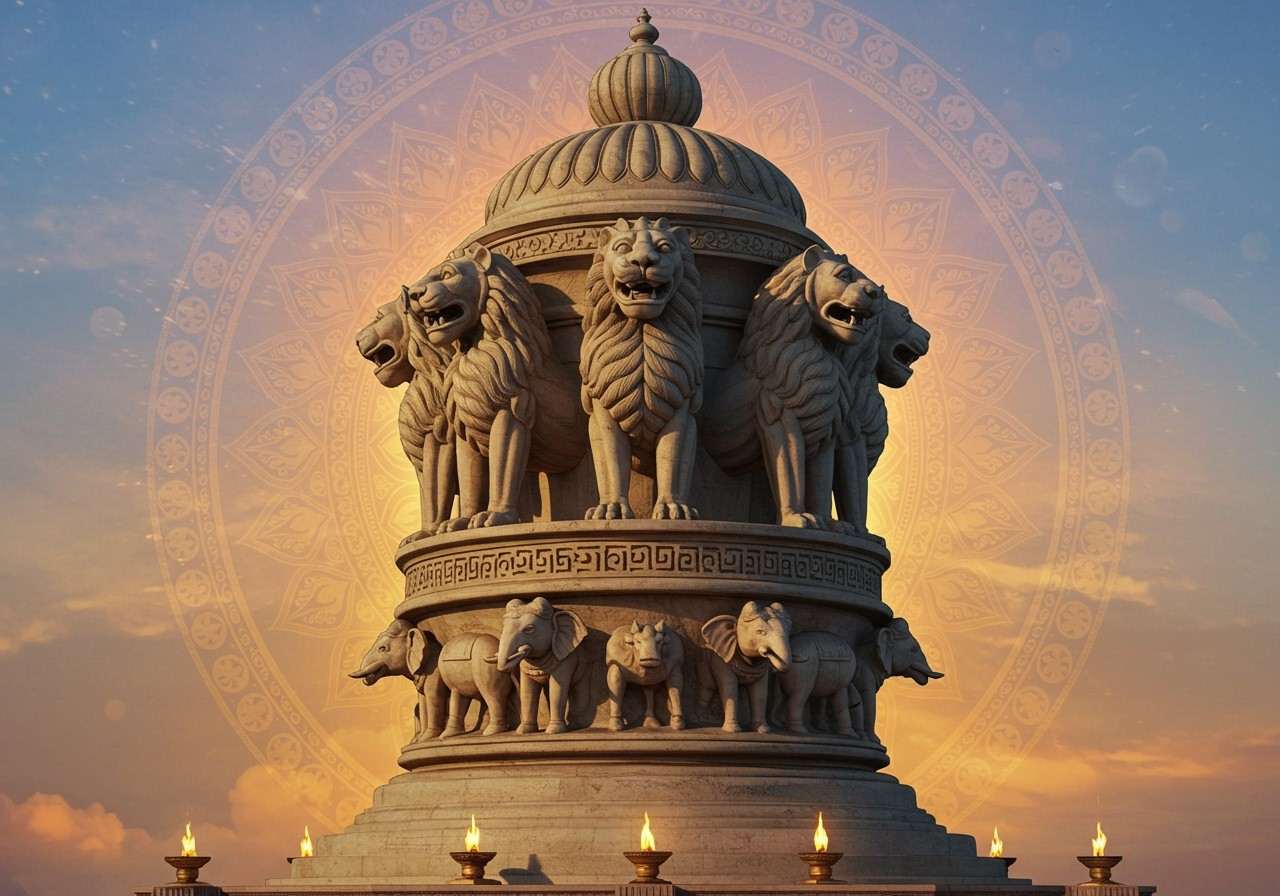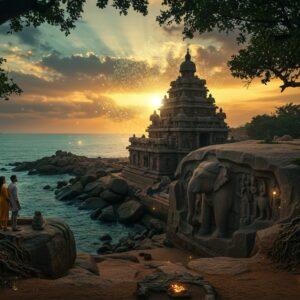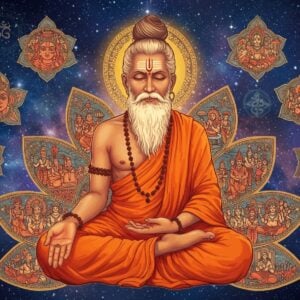
Every time we look at our currency notes or an official government document, we see a symbol that fills our hearts with pride – the majestic Lion Capital of Ashoka. It’s more than just an image; it is a powerful reminder of our glorious past and the values that form the very soul of India. This emblem, a gift from the great Mauryan Empire, is a story etched in stone, a story of strength, courage, and timeless wisdom.

A Glimpse into History: The Mauryan Era’s Gift to India
Let’s travel back in time to the 3rd century BCE, during the reign of Emperor Ashoka. After the heart-wrenching Kalinga War, a profound change came over him. He embraced Buddhism and dedicated his life to spreading the message of Dharma – the path of righteousness and peace. To share these ideals, he erected magnificent pillars across his vast empire, and atop the one at Sarnath, he placed this incredible sculpture.
Sarnath was not just any location; it was the sacred ground where Gautam Buddha delivered his very first sermon after attaining enlightenment. By placing the Lion Capital here, Ashoka was commemorating this pivotal moment and anchoring his rule in moral and spiritual governance.
Decoding the Symbolism: More Than Just Lions
The beauty of the Sarnath capital lies not just in its form, but in its deep, layered meaning. Every element was crafted with a purpose, telling a story of power, philosophy, and universal law.
The Four Majestic Lions
The four lions, standing back-to-back and facing the four cardinal directions, are the most striking feature. They are not roaring aggressively but have a calm, confident posture. These lions represent power, courage, royalty, and authority. Their placement signifies the proclamation of Dharma in every direction, a message of peace and truth reaching all corners of the world. They also beautifully symbolise our nation’s motto of unity in diversity.
The Dharma Chakra (The Wheel of Law)
Below the lions rests the iconic wheel, the Dharma Chakra. This symbol is central to Buddhist philosophy, representing the eternal cosmic law and the path to enlightenment. It’s a symbol of constant movement and progress, a reminder that righteousness is a continuous journey. It is this very chakra that proudly graces the centre of our Indian national flag, Tiranga.
The Animals on the Abacus
The circular base, or abacus, is adorned with carvings of four animals: a galloping horse, a bull, an elephant, and a lion. Historians offer beautiful interpretations for these. Some believe they represent different stages of Lord Buddha’s life, while others suggest they signify Ashoka’s rule over the four quarters of the world. Each animal, full of life and energy, adds to the emblem’s dynamic symbolism.
From Ashoka’s Pillar to India’s National Emblem
When India gained independence, our founding fathers sought a symbol that would capture the spirit of a new, sovereign nation while honouring its ancient heritage. On 26th January 1950, the Lion Capital of Ashoka was officially adopted as the National Emblem of India. It was a perfect choice, embodying the ideals of truth, power, and courage that our nation stands for. Today, it serves as a constant reminder of our sovereignty and our deep-rooted cultural identity.
A Beacon of Culture and Faith
The influence of Ashoka’s emblem extends far beyond governance. It is a masterpiece of Mauryan artistry and has inspired Indian art and architecture for centuries. This tradition of creating magnificent structures that blend art and faith can be seen across India, in timeless marvels like the Mukteshvara Temple. The principles of harmony and moral law embedded in the emblem resonate deeply with our spiritual traditions. These are the very values we try to uphold in our daily rituals and prayers. To bring authenticity and sanctity to your spiritual practices, explore our curated collection of Pooja Samagri at Poojn.in, where every item is sourced with reverence for our culture.
Preserving Our Heritage for Generations to Come
For those who wish to witness this historical marvel up close, the original Lion Capital is lovingly preserved and displayed at the Sarnath Museum, near Varanasi. Seeing it in person is a truly humbling experience, connecting you directly to a legacy that is thousands of years old. Its preservation is a testament to our commitment to safeguarding our national treasures for the generations to follow.
Answering Your Curiosities About Our National Symbol
Many of us hold questions about this revered symbol. For instance, what exactly is the Lion Capital? It is a sculpture featuring four Asiatic lions, originally placed on an Ashoka Pillar in Sarnath during the 3rd century BCE to spread the message of Dharma.
People often wonder about the deep significance of this emblem. It is profoundly important as it symbolises India’s sovereignty, strength, and unity. It’s a proud link to our ancient civilization and a reminder of the moral principles that Emperor Ashoka championed.
A common query is about the meaning of the four lions. These magnificent creatures are symbolic of power, courage, and confidence. Facing the four directions, they also represent the universal spread of Buddha’s teachings of peace and righteousness.
Today, the use of the Lion Capital is widespread and official. As India’s national emblem, it is an integral part of our identity, appearing on our currency, official letterheads, and government buildings, signifying the authority and integrity of the nation.


